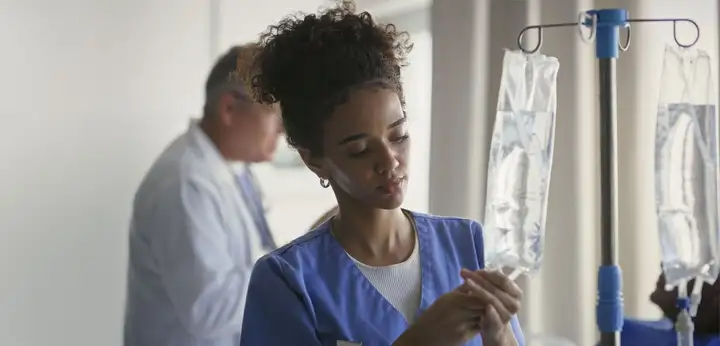
Antibody-drug conjugates
Unlock the potential of ADC packaging that protects every molecule
Antibody-drug conjugates (ADCs) are a rapidly growing and highly promising class of biopharmaceuticals, with over 3,000 active patents projected for 2025 and a market value expected to reach €53 billion by 2030 (Source: GlobalData May 2025). Their complex molecular structure combines a monoclonal antibody, a linker, and a cytotoxic payload to offer targeted cancer therapy with high potency. However, this complexity also introduces significant challenges for ADC packaging, which must ensure product stability, safety, and efficacy throughout the drug’s lifecycle.
Potent therapies, fragile realities: The hidden challenges of ADC packaging
Antibody-drug conjugates (ADCs) promise targeted, high-potency cancer treatment, but their complexity demands more than scientific precision. Whether it’s fogging of the lyophilized drug vials that threatens container closure integrity, light sensitivity that accelerates degradation, or the instability of liquid formulations that risks safety and efficacy, each step in the packaging process must rise to meet antibody-drug conjugate challenges. These challenges aren’t just technical, they are critical to unlocking the full therapeutic potential of ADCs.
EVERIC® vials: Engineered to protect what matters most for ADCs
The complexity of antibody-drug conjugates (ADCs) demands more than conventional packaging - it calls for precision-engineered solutions that protect potency, ensure stability, and meet global regulatory standards.
SCHOTT Pharma’s EVERIC® vial portfolio rises to this challenge with a comprehensive approach to ADC containment. Designed to address the most critical formulation needs - from fogging during lyophilization to light sensitivity and chemical stability - EVERIC® vials deliver performance where it matters most:
- Hydrophobic coatings eliminate fogging during lyophilization and reduce drug loss.
- Amber glass shields light-sensitive formulations from degradation while meeting global regulatory standards.
- Tailored inner surfaces ensure liquid stability across the pH range, minimizing leachables and preserving efficacy.
- EVERIC® lyo vials feature a silicone-free, hydrophobic inner coating applied via Plasma Impulse Chemical Vapor Deposition (PICVD). This covalently bonded layer prevents the formation of a hydration film, which eliminates fogging during lyophilization.
- The hydrophobic coating also improves residual emptying, reduces drug loss and minimizes the need for overfilling, which results in significant cost savings per lyophilized drug vial.
- EVERIC® amber vials are manufactured using FIOLAX® amber glass, which absorbs harmful UV and visible light, protecting light-sensitive ADCs from degradation.
Thanks to a tightly controlled hot forming process and potential dimensional adaptations, SCHOTT Pharma achieves global compliance with USP, Ph. Eur., and JP light transmission requirements, controlled via an in-production release test.
In combination, EVERIC® lyo & amber vials offer both fogging prevention and robust light protection, ensuring product safety and regulatory compliance.
The incorporation of a range of vial options at the stability testing stage of design can offer the possibility of avoiding lyophilization by enabling liquid storage:
- EVERIC® pure – the default choice: offers a homogeneous inner surface that reduces delamination and minimizes leachables as well as pH shift. EVERIC® pure is the starting point for high stability for valuable drugs.
- EVERIC® plus – protection in low pH: a quartz-like SiO₂ inner coating (applied via PICVD) acts as an ion barrier to further reduce leachables and protein adsorption to preserve drug efficacy.
- EVERIC® care – protection in high pH: a Si-O-C-H inner coating (applied via PICVD) provides protection even in high pH environments, ensuring stability for sensitive formulations such as ADCs.

EVERIC® lyo & amber designed for ADCs – No fogging, no overfilling, no compromise
Storing ADCs requires packaging that meets the highest standards of safety and performance. EVERIC® lyo vials eliminate fogging during lyophilization, reduce drug loss by improving residual emptying, and remove the risk of free silicone, offering robust light protection in combination with EVERIC® amber. With even more additional solutions tailored to the unique requirements of ADCs, EVERIC® ensures product integrity, regulatory confidence, and operational efficiency from fill to finish.











